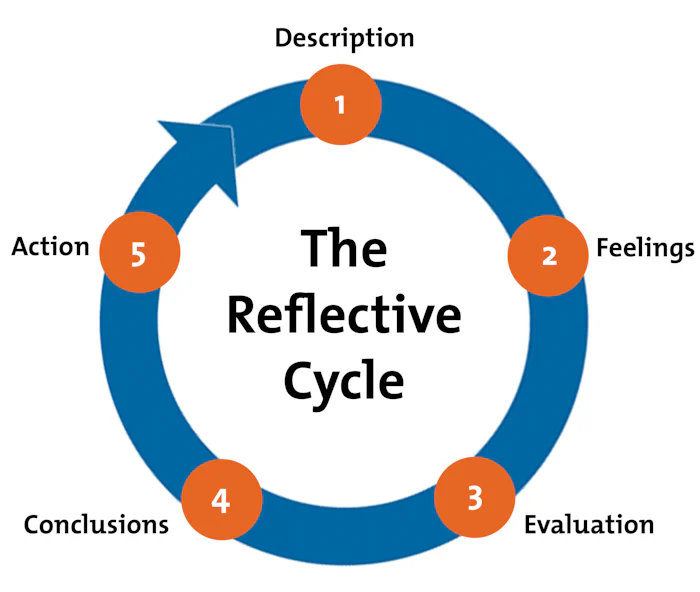Assessment: 1 – Student Number: 23013257 – Word Count: 986
As educators, we often find ourselves grappling with the intricacies of classroom dynamics, striving to cultivate interactive and inclusive learning atmospheres. In this reflective exploration, I intend to delve into my recent classroom conversations which are centered around literary analysis. I will be using Gibbs’ Reflective Cycle as my primary reflection method. From the reading activities outlined in week 1, I found this to be the reflection method I resonated with the most as I mentioned in the group activity.

In this reflection, I intend to examine the wide variety of elements at play and consider the different types of strategies I can use to strengthen my student’s engagement and useful dialogue. The following reflection stems from my experiences as an English teacher in Taiwan. Teaching in Taiwan has presented a unique blend of challenges and opportunities that vary dramatically from my experience in the UK. Navigating the cultural and linguistic landscape requires constant reflection and adaptation to ensure the effectiveness of my classes. It sometimes feels like a never-ending learning experience and through effectively utilizing reflection I feel that I can continue to improve my ability as an educator. With that being said let’s explore one of my most recent experiences.
Description
In a recent session focused on exploring the main themes of a novel, I led the class in a discussion that intended to draw out critical perspectives from my students. Building upon contemporary theories, I tried to structure the conversation in a way that promotes collaborative interpretation and a deep engagement within the text. However, this was not to be the case, despite my careful planning and thoughtful guidance, it became apparent that there were several factors contributing to a rather lackluster outcome. I believe first and foremost the complexity of the text proved too challenging for some students, leading them to feel intimidated and reluctant to attempt any answer. Additionally, the educational system in Taiwan often emphasizes rote memorization and standardized testing, which may not adequately prepare students for the critical thinking and analysis required in interpreting complex texts. There also seems to be a heavy fear of failure or getting questions wrong due to fears of harsh judgment or criticism from their peers or other teachers.
Finally, I seemed to have overlooked that this particularly difficult class was during an extremely stressful period in the academic calendar. Midterms in Taiwan are known for their intensity and high degree of pressure, many students burn out from relentless studying “Cramming” which in turn affects their ability to be fully present in the classroom.
Feelings
My Feelings – As the classroom discussion and progress of the class hit a snag it became apparent that this was going to be a long and difficult lesson with very little engagement. I experienced a blend of frustration and introspection. There was a noticeable difference in my expectations considering the amount of time and effort that had gone into carefully crafting the lesson plan and the reality of how the class was playing out in front of me. It was disheartening that my effort was going to waste and my aspirations for active student engagement were met with a passive response from the majority of the class. However, drawing from the insights gathered from Bassot’s (2016) “The Reflective Practice Guide, I began to view this experience as a challenge and an opportunity for growth.

Evaluation
With all things considered, I embarked on a process of deep reflection. I started to question the efficacy of my instructions and strategies and whether or not I had adequately accounted for the unique factors affecting my students, particularly the demanding midterm period. This critical self-analysis prompted a reevaluation of my teaching approach and inspired a commitment to enhancing student support mechanisms.
Conclusions / Reflections
Upon further critical reflection, I identified several factors all of which contributed to the poor performance and engagement of my class. Firstly the cognitive demands inherent in literary analysis posed a significant barrier for some students. As evidenced by Anderson and Krathwohl (2001), this academic task requires higher-order thinking skills such as analysis, synthesis, and evaluation, which can be challenging for learners, particularly when encountering complex texts.
Upon deep reflection on my instructional approach, I realised that my facilitation techniques had inadvertently impeded the involvement of my students. While I tried my best to create an interactive and inclusive classroom environment, I acknowledge that my methods of questioning and support may not have been sufficiently diverse or customised to meet the needs of my students.
Additionally, I overlooked contextual factors such as the stressful timing of the discussion amidst the midterm period which likely impacted my student’s readiness and motivation to engage. The intense academic pressure experienced during this period most likely left many students feeling mentally exhausted and less inclined to actively participate in class.
Actions going Foreword
Going forword, I intend to introduce more stress-relief techniques, like short mindful exercises or more interactivties activities that are more tailored to ease student anxiety, which will hopefully boost their involvment in class discussions. I also hope to assess the ability of my students better and understand their limitatons and capabilities in order to create a lesson plan more appropriate to the overall level of the class.
I recognised how socio-cultural factors impact classroom interactions, drawing from Gee’s (1996) work on discourse communities. Considering diverse cultural backgrounds and communication styles, I pondered how they might influence student engagement and how i can implement my findings in my future classes.
References:
Anderson, L. W., & Krathwohl, D. R. (2001). A taxonomy for learning, teaching, and assessing: A revision of Bloom’s taxonomy of educational objectives. Longman.
Bassot, B. (2016). The reflective practice guide: An interdisciplinary approach to critical reflection. Routledge.
Gee, J. P. (1996). Social linguistics and literacies: Ideology in discourses (2nd ed.). Routledge.